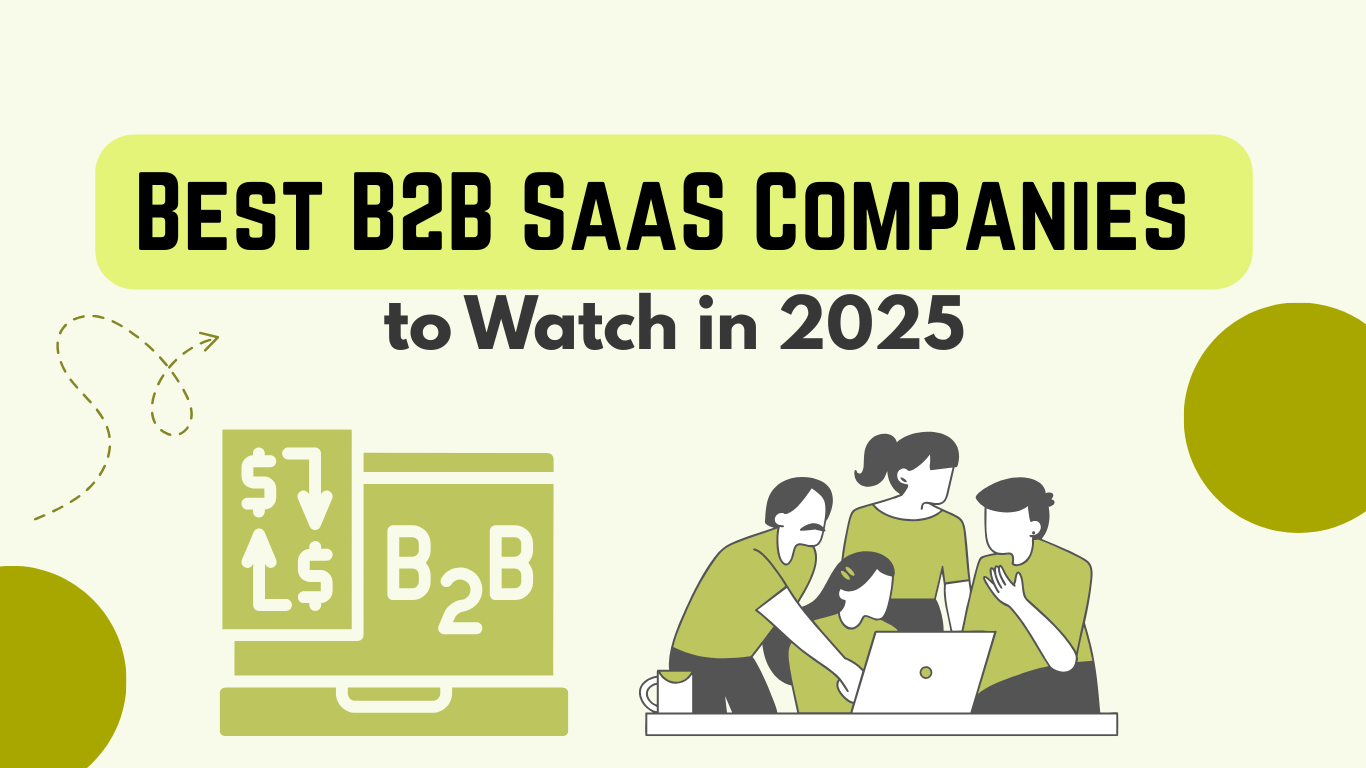The software market’s getting crowded, but these B2B SaaS companies are actually worth paying attention to in 2025. ProProfs Project, Zoho Projects, Bitrix24, and Asana have pushed past the usual tech noise with tools that don’t just look good on paper, they work.
These aren’t your typical over-promised, under-delivered platforms. Each one’s taken a real problem (like teams scattered across time zones or projects that never seem to end) and fixed it without the usual tech buzzwords and fancy promises. They’re just doing what software should: making work easier, period.
Stick around to see how each one stands out from the pack.
Key Takeaway
- Market Leaders like ServiceNow, Square, Zoom, and Snowflake dominate with enterprise-ready SaaS platforms that automate workflows, enable collaboration, and scale across industries.
- Mid-Market Specialists such as Workday, Veeva, HubSpot, and Slack drive growth by solving industry-specific problems in HR, pharma, marketing, and team collaboration.
- Emerging Disruptors including Lemlist, Simply Do, Ahrefs, Drift, Namely, and Loom are reshaping SaaS with AI-driven, niche-first solutions that make business tools more personal, efficient, and user-friendly.
Best B2B SaaS Companies to Watch in 2025: Market Leaders and Innovators
Look around any office these days, and you’ll see screens filled with software that powers everything from team chats to payment processing. The B2B SaaS world isn’t just growing, it’s practically exploding with innovation. While hundreds of companies compete for attention, a select few have risen above the noise, proving themselves essential to how modern businesses operate.
| Company | Market Cap (2025) | Core Focus | Key Features |
| ServiceNow, Inc. | $109.85B | IT Management & Workflow Automation | Low-code tools, AI-powered automation, enterprise-wide systems, strong security |
| Square, Inc. | $108.15B | Digital Payments & Business Management SaaS | All-in-one platform, real-time analytics, easy integrations, payroll & marketing |
| Zoom Video Communications, Inc. | $106.65B | Cloud Communication Platforms | AI transcription, hybrid work support, simple UI, scalable for large events |
| Snowflake Inc. | $74.26B | Data Storage & Analytics Platform | Multi-cloud compatibility, strong security, large-scale analytics, data handling |
ServiceNow, Inc: IT Management and Workflow Automation Solutions
ServiceNow sits at the top with a whopping $109.85 billion market cap, and there’s a good reason why. They’ve mastered the art of making complex IT stuff actually manageable, much like how top SaaS SEO agencies simplify growth challenges for scaling software companies. Their standout features include:
- Low-code development tools that don’t require a PhD in computer science
- AI-powered workflow automation that actually works
- Enterprise-wide management systems that talk to each other
- Security operations that won’t keep IT directors up at night
The real magic happens in how they’ve simplified massive enterprise operations, think telecommunications giants and Fortune 500 companies running smoother because of their tools.
Square, Inc.: Digital Payments and Business Management SaaS
Square ($108.15 billion market cap) started with those little white payment dongles you’ve seen at coffee shops, but they’ve grown into something much bigger. Here’s what makes them special:
- An all-in-one platform that handles everything from payroll to marketing
- Easy-to-use tools that don’t require a tech background
- Real-time analytics that actually make sense
- Integration capabilities with practically everything
Zoom Video Communications, Inc.: Cloud Communication Platforms
Remember when nobody knew what Zoom was? Now it’s worth $106.65 billion and has become as common as email. [1] They’ve managed to stay on top by:
- Keeping things simple enough for grandparents to use
- Adding AI features that transcribe meetings automatically
- Supporting massive online events without crashing
- Creating tools that make hybrid work actually work
Snowflake Inc: Data Storage and Analytics Platform
At $74.26 billion, Snowflake’s turned data storage from a necessary evil into a powerful business tool. Their platform handles:
- Massive amounts of data without breaking a sweat
- Complex analytics that don’t require a data science team
- Multi-cloud solutions that work across different systems
- Security features that meet even the strictest industry rules
Between these giants, you’re looking at the future of how businesses will operate, more connected, more automated, and (hopefully) less complicated.
Which Mid-Market B2B SaaS Companies Drive Enterprise Resource and Industry-Specific Solutions?
While the tech giants grab headlines, it’s the mid-market players who often solve the real day-to-day headaches in specific industries. These companies might not be household names, but they’re the ones keeping HR departments running, helping scientists manage clinical trials, and making sure marketing teams hit their targets.
| Company | Market Cap (2025) | Industry Focus | Key Features |
| Workday, Inc. | $56.2B | HR & Finance Management | Payroll, HR integration, forecasting, customizable workflows |
| Veeva Systems Inc. | $48.23B | Pharma & Life Sciences | Clinical trial management, regulatory compliance, pharma-specific CRM |
| HubSpot, Inc. | $26.30B | Marketing & CRM | Sales-friendly CRM, automation, content & SEO tools, analytics |
| Slack Technologies, Inc. | $26.22B | Team Collaboration | Organized conversations, automation, searchability, integration capabilities |
Workday, Inc: HR and Finance Management Software
With $56.2 billion in market cap, Workday’s become the go-to name for companies who want their HR and finance teams to actually talk to each other. Their main strengths include:
- An HR system that doesn’t feel like it’s stuck in 1995
- Payroll tools that actually make sense
- Smart forecasting that helps predict hiring needs
- Custom workflows that fit how people really work
The best part? They’ve figured out how to make all this stuff work together without requiring an IT degree to use it, a kind of efficiency businesses also look for when tracking their authority with backlink monitor tools.
Veeva Systems Inc: SaaS for Science and Pharmaceutical Industries
At $48.23 billion, Veeva’s carved out a sweet spot in the pharmaceutical world. They get that working in regulated industries is different, you can’t just wing it when lives are at stake. Their platform handles:
- Clinical trial management that keeps the FDA happy
- Marketing tools that won’t get you in trouble
- Supply chain tracking that actually works
- Compliance features built right in
HubSpot, Inc: Marketing Automation and CRM Tools
HubSpot ($26.30 billion) started as a marketing tool but grew into something much bigger. [2] Today, they’re the Swiss Army knife of digital marketing and sales, offering:
- CRM tools that sales teams actually want to use
- Marketing automation that doesn’t feel robotic
- Analytics that tell you what’s really working
- Content tools that help you show up in Google
Slack Technologies, Inc.: Collaboration and Workflow Automation
Worth $26.22 billion, Slack turned office chat into something actually useful. They’ve managed to:
- Replace endless email chains with organized conversations
- Automate the boring stuff nobody wants to do
- Connect with practically every other business tool out there
- Keep everything searchable and secure
These companies prove you don’t need to be a $100 billion giant to make a huge difference in how businesses work. They’ve found their niches and stuck to what they do best, solving specific problems really well.
What Are the Promising Emerging B2B SaaS Companies Disrupting the Market in 2025?
Credits: MicroConf
Think of these companies as the new kids who showed up to school with the latest tech nobody else had seen yet. While the big names duke it out at the top, these smaller players are quietly changing how businesses handle everything from sales emails to team videos.
| Company | Revenue/Scale | Focus Area | Key Features |
| Lemlist | $10M+ revenue | Personalized Email Marketing | Human-like email automation, AI timing optimization, follow-up sequences |
| Simply Do | Early-stage | AI Project Management | Smart task ranking, AI deadline management, streamlined communication |
| Ahrefs | Strong SaaS adoption | SEO & Marketing Data | Competitive research, rank tracking, keyword/content analysis |
| Namely | Growing HR SaaS | HR Management | Payroll, recruiting, analytics, employee record management |
| Drift | 50,000+ businesses | Conversational Marketing | Chatbots, lead qualification, automated routing, human-like messaging |
| Loom | Strong SMB adoption | Video Messaging | Screen recording, video messaging, searchable video library |
Lemlist: Personalized Email Marketing and Sales Engagement
Pulling in over $10 million yearly, Lemlist’s cracked the code on making mass emails feel personal. Sales teams love it because:
- It writes emails that don’t sound like robots wrote them
- Creates follow-up sequences that actually make sense
- Uses AI to figure out when people are most likely to respond
- Tracks what works (and what bombs) in real-time
Simply Do: AI-Powered Enterprise Communication and Project Planning
Simply Do might sound like a basic name, but there’s nothing basic about how it’s changing project management. The platform tackles:
- Smart task ranking that cuts through the noise
- Deadline management that doesn’t give you headaches
- Team communication that doesn’t get lost in the shuffle
- AI-powered suggestions that actually help
Ahrefs: SEO and Marketing Data Solutions
When it comes to figuring out what makes Google tick, Ahrefs has become the go-to tool. Marketing teams rely on it for:
- Finding out what content actually works
- Spotting opportunities competitors missed
- Tracking rankings without losing their minds
- Understanding what users really want
Namely: Human Resource Management Platform
Namely’s taken all the painful parts of HR and made them, well, less painful. They focus on:
- Making payroll less of a headache
- Keeping employee records that make sense
- Recruiting tools that save time
- Analytics that tell the real story
Drift: Conversational Marketing and Sales Automation
With 50,000 businesses already on board, Drift’s changing how companies talk to potential customers. Their chatbots and automation tools:
- Turn website visitors into conversations
- Qualify leads while you sleep
- Route the right chats to the right people
- Keep the personal touch in automated messages
Loom: Video Messaging and Screen Recording for Teams
Loom figured out that sometimes it’s easier to show than tell. They’ve made it simple to:
- Record quick videos instead of writing long emails
- Share screen recordings without the tech hassle
- Keep everyone in the loop without more meetings
- Build a searchable video knowledge base
These companies might not be the biggest names in tech yet, but they’re solving real problems in fresh ways, similar to how SaaS marketing tools quietly become essential for teams before anyone notices. That’s usually how the next big thing starts.
How Are Key Industry Trends Shaping B2B SaaS Companies to Watch in 2025?
Walking through any modern office shows just how much has changed in business software. Gone are the clunky interfaces and endless manual tasks, today’s SaaS tools practically run themselves. Five key shifts are pushing this evolution, and they’re worth keeping an eye on.
AI-Powered SaaS Applications as Mission-Critical Tools
Remember when AI was just a buzzword? Not anymore. These days, it’s doing the heavy lifting across nearly every business function. Sales teams use it to spot promising leads, HR departments let it screen resumes, and marketing folks rely on it to predict campaign performance. The real game-changer? These tools learn and get smarter over time, making yesterday’s impossible tasks today’s routine.
Vertical SaaS Focus on Regulatory Compliance and Industry Specificity
One size definitely doesn’t fit all anymore. Healthcare companies can’t use the same software as restaurants, the rules are just too different. That’s why we’re seeing more SaaS companies build tools specifically for one industry. They’re not trying to please everyone; they’re trying to solve specific problems really well. And it’s working.
Product-Led Growth and Self-Serve SaaS Models
Nobody wants to sit through three demos and talk to five salespeople anymore. Modern SaaS companies get this. They’re building products that sell themselves, clear pricing, easy trials, and interfaces that make sense from day one. It’s like test-driving a car without the pushy salesperson hovering nearby.
Cybersecurity as a Baseline Requirement in SaaS Offerings
These days, good security isn’t a nice-to-have, it’s as basic as having a login screen. Every week brings news of another data breach, and companies aren’t taking chances. SaaS providers are building security into everything they do, not just bolting it on as an afterthought.
Growth Driven by Government and Regulated Sector Demand
Even the most traditional institutions, governments, banks, healthcare providers, are moving to the cloud. They’re tired of maintaining ancient systems and paying for endless upgrades. But they need software that follows their strict rules, creating huge opportunities for SaaS companies who can meet these demands.
Conclusion
Here at Create and Grow, we’ve seen firsthand how tough it can be to stand out in the crowded SaaS space. While the big players spend millions on ads, we focus on something that actually lasts, building your site’s authority through quality backlinks and smart SEO.
Our team knows the SaaS world inside and out, and we’ve got the tech and tools to help you climb those search rankings.
Ready to stop watching from the sidelines? Drop us a line, and let’s map out a plan to get your company noticed.
References
- https://investors.zoom.us/static-files/b0dac8db-4e35-4dd8-a148-c02a0029b1c5
- https://substack.com/home/post/p-151459235?utm_campaign=post&utm_medium=web
Related Articles
- https://createandgrow.com/top-11-saas-seo-agencies/
- https://createandgrow.com/backlink-monitor-tools/
- https://createandgrow.com/saas-marketing-tools/
Frequently Asked Questions





